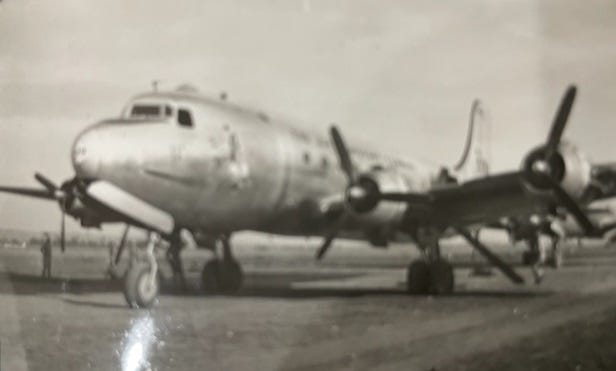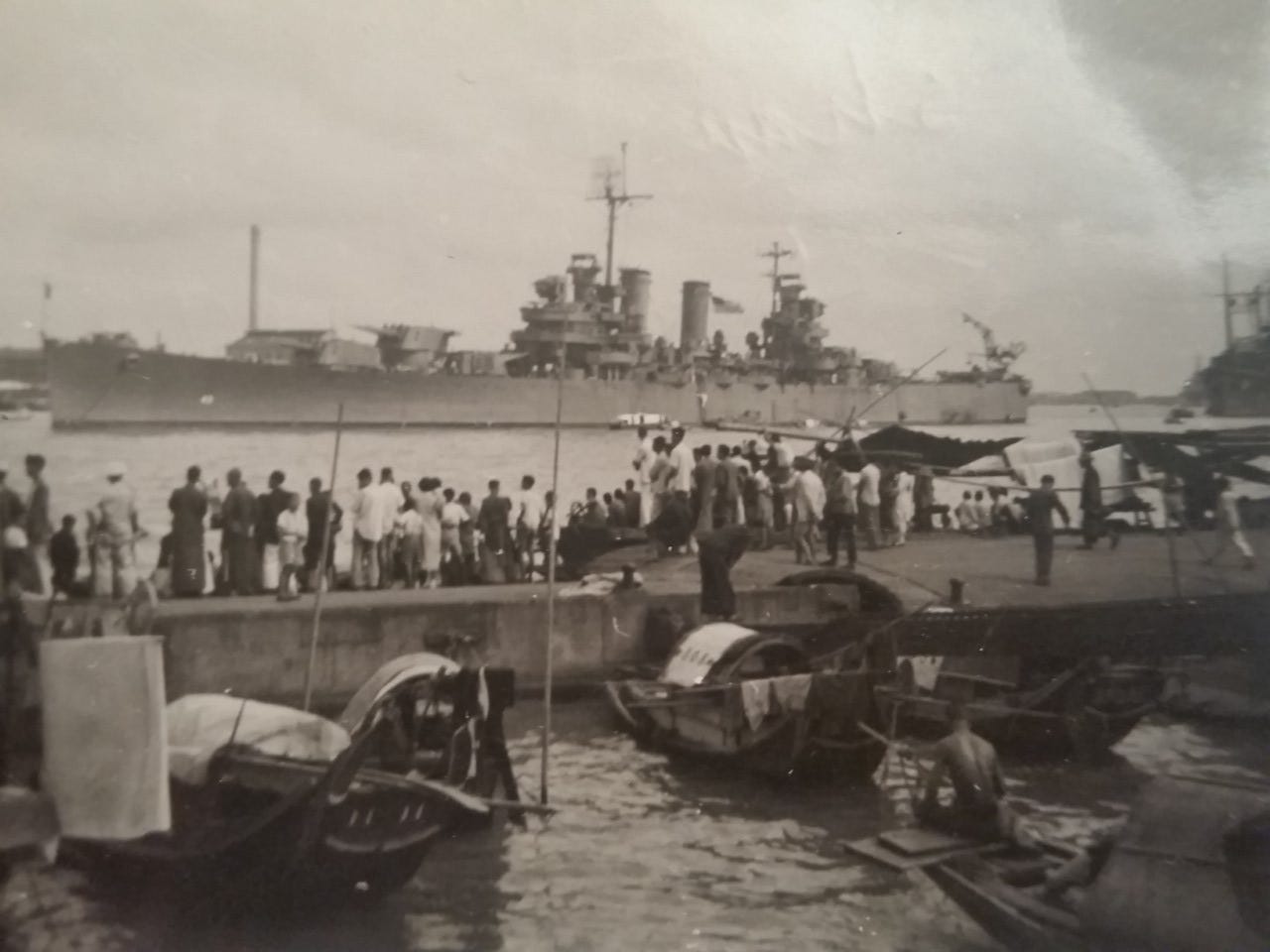As U.S. forces began to arrive in Shanghai by air after Operation Sparrow and the formal surrender of Japan on September 2, 1945, Peter Kim and his comrades in the China Theater G-5 staff took over the administration of the city. Capt. Robert Peaslee oversaw the dismantling of Japanese control over the Shanghai Waterworks, the Shanghai Power Company, and the Shanghai Telephone Company and ensured the operation of these essential services. Lieutenant Kim supervised the supply of food and other life support to the people in the liberated internment camps and organized the restoration of their homes and other property, in a race against time as Chinese civilians and departing Japanese soldiers looted anything that they could carry away.
Too busy with his duties for any personal matters, Peter did not visit his family until well into September. He returned to Route Père Robert in the French Concession driving a U.S. Army jeep, wearing the uniform of a U.S. Army lieutenant. His mother, David, Betty, and Arthur welcomed him back joyfully but still in disbelief. Not long before, they had not known whether he was dead or alive. Now he was back and wearing the uniform of an officer in the U.S. Army.
Richard was the next to return. He arrived with the first wave of U.S. Army personnel sent from Kunming to set up U.S. military bases in liberated Shanghai, designated the Shanghai Base Command. Barely older than eighteen years of age, he already held the rank of sergeant, only nine months after enlisting. Flying in an airplane for the first time in his life, more than a year after he and Peter had turned down rides in P-38 Lightning fighters while escaping Shanghai in June 1944, he landed at Longhua airfield in a C-54 transport on September 8, 1945.
While the C-54 landed and his outfit moved overland to downtown Shanghai, Sergeant Kim saw the strange sight of armed Japanese soldiers surrounding his plane on the tarmac and patrolling the streets. The Imperial Japanese Army in Shanghai had not yet formally surrendered, and its units continued to control the airfield and secure the city, now under U.S. supervision. Arriving at a hotel that was to serve as their living quarters, Richard immediately got on a telephone and had the Shanghai Telephone Company’s operator connect him to his family’s house. Eventually Peter picked him up in a jeep and drove him home for his reunion with the family.
On October 27, 1945, Sgt. Richard Kim showed up at the house with a jeep and told everyone that they were going to an official celebration of Navy Day that he had arranged for them to attend. David, Betty, and Arthur crammed into the jeep for the ride through the city to the distant Shanghai Bund waterfront. There they boarded the USS Nashville, a 10,000-ton cruiser that was the flagship of the U.S. Seventh Fleet’s Task Force 73 in Shanghai.
The Nashville had been thoroughly prepared to host an event befitting the U.S. Navy’s flagship in Shanghai on a global day of commemoration for the Navy’s contributions to victory in the Second World War. The galley served a seemingly limitless supply of steaks for the ship’s guests, followed by the Navy’s famous ice cream for dessert. For entertainment, there was a newly released movie: State Fair, a Rodgers and Hammerstein musical in Technicolor starring Jeanne Crain and Dana Andrews, who later appeared in The Best Years of Our Lives, the renowned 1946 film about veterans coming home from the Second World War.
The four Kim siblings ate in a way that they had not experienced since before the war, and the color film set in the Iowa State Fair was a brief glimpse of the faraway American homeland that David and Betty had not seen for years and where Richard and Arthur had never been.
After the party, Richard drove everyone home in a jeep. There they were surprised to find their mother sitting and talking with a man in a U.S. Army uniform with lieutenant’s bars on it. It was their brother James, who had last been in the house eight years earlier as a sixteen-year-old boy.
Lt. James Kim had been in Korea with the 40th Infantry Division, trying to find a way to return to Shanghai to find his family. The division had been returning veteran soldiers like him to the United States to be discharged and sent home, but he had to create his own way home. He did so similarly to how he had fought his way out of second-class citizen status and discharge from the Army in December 1941. He persuaded a chaplain to support a request for an emergency leave of absence to look for his family in Shanghai. His demand, backed by a clergyman, proved to be persuasive, and the division staff approved the request.
In late October, James again boarded a Landing Ship Tank (LST), this one part of the U.S. Navy’s shuttle service between Pusan and port cities in China. At the Shanghai waterfront, he hired a pedicab to take him to the family house in the French Concession. With childhood memories of rampant crime in the streets of Shanghai, he kept his .45 pistol out of its holster and in his hand, ready to use as soon as necessary, all the way from the waterfront to Route Père Robert.
When he found what he thought was the right house and knocked on the door, an old woman answered and told him that no one was home. Neither he nor she recognized each other. He began to back away, but stopped himself and asked hesitantly, “Mom?”
Suddenly she realized that she was looking at her boy whom she had not seen for eight years, now grown into a man, and he recognized his mother, whom the war years had aged and made cautious. Both deliriously happy, they went into the empty house and began the long process of trying to talk through some of the things that had happened to each of them over the years.
David, Betty, Richard, and Arthur walked in later that day after the Navy Day festivities. David, Richard, and Arthur had not seen James since he had left home in September 1937, and Betty had not since she had left him in Los Angeles to return to Shanghai in 1939. James needed a moment to recognize Richard, now 18 years old and in the uniform of a U.S. Army sergeant. He did not recognize Arthur at all. His youngest brother, only seven years old in 1937, was now an unfamiliar-looking teenager.

In this way, on October 27, 1945, the Kim family reunited completely for the first time since the Second World War had begun in Asia in 1937. Lee Chung Sil could be relieved that all six of her children had survived the war, and proud that all of them had contributed to the defeat of the enemy of their family and the United States, three of them returning to her as officers and noncommissioned officers in the U.S. Army. She and their late father Kim Chang Sei had married 35 years earlier with a vision of themselves and their children becoming Americans. Deferred for two decades, their dream was a step closer to becoming reality.
This series previews my upcoming book Victory in Shanghai: A Korean American Family’s Journey to the CIA and the Army Special Forces, whose publication is expected by June 1, 2025. You can pre-order it now through Potomac Books, an imprint of the University of Nebraska Press, at this link, on Amazon at this link, or through your favorite local independent bookseller.
Subscription to this series is free.
If you know anyone who may be interested in this series, please share it with them.









